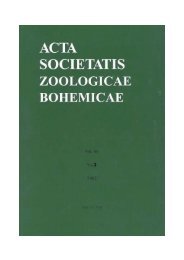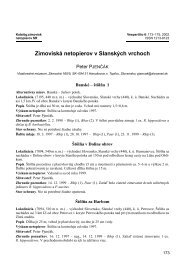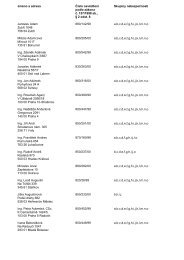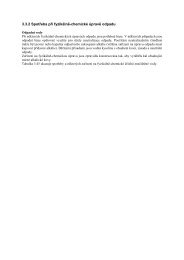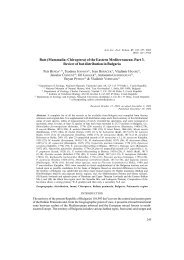Untitled
Untitled
Untitled
Create successful ePaper yourself
Turn your PDF publications into a flip-book with our unique Google optimized e-Paper software.
Asteroids: Their composition and impact threat<br />
enes, while diogenites are predominantly magnesian orthopyroxene.<br />
Howardites are breccias of eucritic and diogenitic<br />
material. Pallasites are mixtures of metallic iron<br />
and olivine. We do not appear to be sampling the mantles<br />
of these differentiated bodies (e.g. Burbine et al. 1996);<br />
however, we do appear to be sampling the mantles of veryreduced<br />
differentiated bodies in the form of aubrites.<br />
Iron meteorites are composed of metallic iron with<br />
5–20% Ni plus accessory phases such as sulfides,<br />
schreibersite, and silicate inclusions. Iron meteorites are<br />
classified according to siderophile (“iron-loving”) element<br />
(Ga, Ge, Ir, Ni) concentrations. Of the thirteen groups of<br />
iron meteorites, ten (IC, IIAB, IIC, IID, IIF, IIIAB, IIIE,<br />
IIIF, IVA, IVB) have fractional crystallization trends suggestive<br />
of prolonged cooling as expected from the cores of<br />
differentiated bodies. Three of the groups (IAB, IIE, and<br />
IIICD) do not display well-developed fractional crystallization<br />
trends and contain abundant silicate inclusions,<br />
which argues that they are not core fragments. Approximately<br />
90 irons (Grady 2000) are not classified as members<br />
of the 13 groups and are labeled anomalous. These<br />
ungrouped irons are believed to require 50-70 distinct parent<br />
bodies (Wasson 1995, Burbine et al. 2002b).<br />
Other types of differentiated meteorites have undergone<br />
varying amounts of melting. These include a number<br />
of primitive achondritic meteorites (acapulcoite-lodranites,<br />
winonaites), which are samples of partially differentiated<br />
asteroids. These meteorites are mixtures of olivine,<br />
pyroxene, and metallic iron. Mesosiderites are breccias<br />
composed of HED-like clasts of basaltic material mixed<br />
with metallic clasts. One possible scenario for the formation<br />
of the mesosiderites is the disruption of an asteroid<br />
with a molten core (Scott et al. 2001). Rounding out the<br />
differentiated meteorites are the olivine-dominated brachinites<br />
and the carbon-rich ureilites, whose origins are<br />
still being debated (e.g. Mittlefehldt et al. 1998).<br />
Meteorite densities and strengths<br />
Consolmagno and Britt (1998), Flynn et al. (1999), and<br />
Wilkinson and Robinson (2000) have recently done studies<br />
of meteorite bulk densities. The only CI chondrite<br />
measured had a bulk density of 1.58 g/cm 3 while the bulk<br />
densities of CM chondrites were 2.08–2.37 g/cm 3 . CO<br />
chondrites (2.36–2.98 g/cm 3 ) and CV chondrites<br />
(2.60–3.18 g/cm 3 ) tended to have slightly higher bulk densities.<br />
The only enstatite chondrite measured had a bulk<br />
density of 3.36 g/cm 3 . On average, ordinary chondrites<br />
(3.05–3.75 g/cm 3 for the most reliable measurements)<br />
have the highest bulk densities of the chondrites.<br />
HEDs have bulk densities of 2.99–3.29 g/cm 3 . Stonyirons<br />
such as mesosiderites (4.16–4.22 g/cm 3 ) and pallasites<br />
(4.82–4.97 g/cm 3 ) have higher bulk densities due to<br />
the presence of significant amounts of metallic iron. As expected,<br />
iron meteorites tend to have the highest bulk densities<br />
of all meteorite types (6.99–7.59 g/cm 3 for relatively<br />
unweathered specimens).<br />
Table 1. Meteorite groups<br />
Groups Composition* Fall percentages # (%)<br />
Carbonaceous chondrites<br />
CI phy, mag 0.5<br />
CM phy, toch, ol, 1.7<br />
CR phy, px, ol, met 0.3<br />
CO ol, px, CAIs, met 0.5<br />
CH px, met, ol, Only finds<br />
CV ol, px, CAIs 0.6<br />
CK ol, CAIs 0.3<br />
Enstatite chondrites<br />
EH enst, met, sul, plag, ± ol 0.8<br />
EL enst, met, sul, plag 0.7<br />
Ordinary chondrites<br />
H ol, px, met, plag, sul 34.1<br />
L ol, px, plag, met, sul 38.0<br />
LL ol, px, plag, met, sul 7.9<br />
R chondrites ol, px, plag, sul 0.1<br />
Primitive achondrites<br />
Acapulcoites a px, ol, plag, met, sul 0.1<br />
Lodranites a px, ol, met, ± plag, ± sul 0.1<br />
Winonaites ol, px, plag, met 0.1<br />
Differentiated achondrites<br />
Angrites TiO 2-rich aug, ol, plag 0.1<br />
Aubrites enst, sul 0.1<br />
Brachinites ol, cpx, ± plag Only finds<br />
Diogenites b opx 1.2<br />
Eucrites b pig, plag 2.7<br />
Howardites b eucritic-diogenitic breccia 2.1<br />
Ureilites ol, px, graph 0.5<br />
Stony-irons<br />
Mesosiderites basalt-met breccia 0.7<br />
Pallasites ol, met ol, met 0.5<br />
Irons c met, sul, schreib 4.2<br />
Table is revised from tables found in Burbine et al. (2002b).<br />
* Minerals or components are listed in decreasing order of average abundance.<br />
Abbreviations: ol – olivine, px – pyroxene, opx – orthopyroxene,<br />
pig – pigeonite, enst –enstatite, aug – augite, cpx – clinopyroxene, plag<br />
– plagioclase, mag – magnetite, met – metallic iron, sul – sulfides, phy –<br />
phyllosilicates, toch – tochilinite, graph – graphite, CAIs – Ca-Al-rich<br />
refractory inclusions, schreib – schreibersite, ± – may be present<br />
# Fall percentages are calculated from the 942 classified falls that are listed<br />
in Grady (2000), Grossman (2000), and Grossman and Zipfel (2001).<br />
a Acapulcoites and lodranites appear to come from the same parent body<br />
(e.g. Mittlefehldt et al. 1998).<br />
b Howardites, eucrites, and diogenites (HEDs) appear to come from the<br />
same parent body (e.g. Mittlefehldt et al. 1998).<br />
c There are 13 iron meteorite groups plus ~100 ungrouped irons.<br />
In terms of physical strength, most chondritic meteorites<br />
can be easily crushed into powders with a mortar<br />
and pestle. Meteorites containing phyllosilicates tend to be<br />
the most fragile with the CI chondrites being the weakest<br />
of these objects with laboratory crushing strengths of 1–10<br />
bars (e.g. Lewis 2000). What cannot be easily pulverized<br />
is metallic iron. Metallic iron is ductile and tends to flatten<br />
and elongate while being crushed at room temperatures. It<br />
is unclear how ductile metallic iron is at the colder temperatures<br />
found in the asteroid belt.<br />
Iron meteorites are extremely strong with strengths of<br />
approximately 3.5 kbars (e.g. Lewis, 2000). The much<br />
stronger physical strength of irons allows them to survive<br />
in space much longer than stony bodies as seen by their<br />
longer cosmic ray exposure ages. Cosmic ray exposure<br />
ages record the time an object has spent as a meter-sized<br />
245



